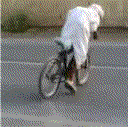Rain
There's nothing magical about riding fast in the rain. Moisture doesn't change vehicle dynamics. All the principles you use in the dry also apply in the wet. Modern tires -- the latest generation in particular -- provide excellent traction in the wet. There are factors you need to take into account to go fast, though...
Give the Tires a Chance
In the wet tires take longer to adapt to new demands. A tire can break free easily if forces are fed into it too quickly. Braking hard before weight transfer has developed will lock up the stickiest sport tire. Countersteering suddenly can break the front loose. Accelerating too hard can throw the rear into a vicious slide. Nevertheless, all this is easily controllable. All you have to do is remember how vehicle and tire dynamics work, and always give the tire a chance to catch up with the bike.
Don't Forget How to Ride
The same techniques you use in the dry are the ones you use in the wet. Tires still have most traction when they have most weight one them. Smooth transitions between braking and turning, and turning and accelerating, still give you the most traction. In fact, it's more important in the wet to do it right, because it's easier to break the tires free with sudden changes. Build the forces smoothly -- braking, cornering, accelerating -- and your tires will reward you with good traction.
Remember Dynamics
Let's look at approaching a slow corner at high speed, like Courage at VIR. As you approach the end of the straight, you need to allow more space for braking -- not just because you can do less braking before locking up, but because you have to build your braking force more slowly.
You come out of your tuck and start squeezing the brakes. As you brake, weight transfers to the front. As weight transfers, the front has more traction. Continue to squeeze the brakes on harder -- as weight transfer builds, you'll be able to brake harder. The more you brake, the harder you can brake! You'll find that provided you squeeze the brakes, and let the weight transfer forward, you'll be able to brake almost as hard in the wet as in the dry.
So now you're approaching the corner under hard braking. There was never a better time to take advantage of trail-braking! With the extra traction you get from the weight transfer, you can turn in quite rapidly under braking. Still, it is a wet track, so give the front tire a chance to build the cornering force -- don't snap into a countersteer, keep your inputs smooth and progressive.
Now we've turned into the corner. We're still braking. As the cornering force builds, that's giving your extra force on the tires -- trail off the brakes as they're no longer needed, and start to roll on smoothly before the apex.
Once again, the tires need longer to build forces. Don't roll on as hard as you would in the dry, because the sudden torque can break the rear loose. But do roll on, because like braking, the more you roll on and transfer weight to the rear, the more the tire can handle the acceleration.
So the very same techniques you use in the dry are exactly what you need to do in the wet. You'd be surprised how fast you can actually go in the rain, provided you remember how dynamics work, and ride properly.
From TrackDoD Novice Group Orientation
Subscribe to:
Post Comments (Atom)



No comments:
Post a Comment